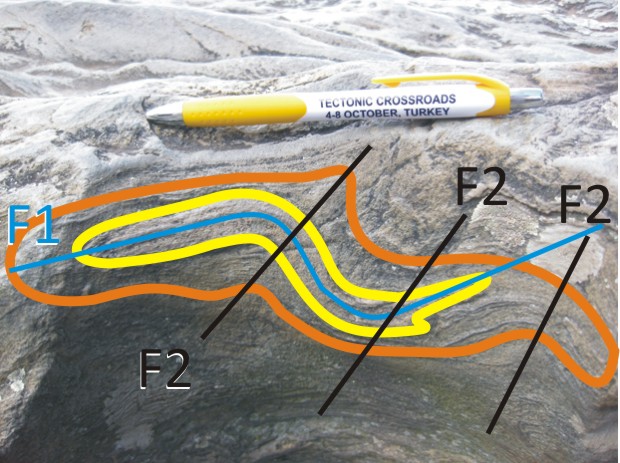A week ago today, I went out on the Billy Goat Trail (near Potomac, Maryland) with a group of students: five from George Mason University’s GeoClub, and two that are current Physical Geology Honors students with me at Northern Virginia Community College. One of my students, Robin, observed this lovely fold, and called my attention to its gummy-worm-like form. When we saw it, we all knew it was destined to be featured on Mountain Beltway as a “Friday Fold:”
These rocks are meta-graywackes of the Mather Gorge Formation, where beds of mudstone between the original graywacke layers have been metamorphosed to a muscovite schist. These layers were then folded — not once, but twice — to produce the fold we see here. An annotated copy of the photo would look like this:
The yellow and orange lines are traces of the compositional layering in the rocks, and the blue line shows the trace of the axial olane from the first episode of folding (“F1”), with the black lines labeled “F2” showing the more recent folds’ axial plane traces. Note that they overprint the first fold, and deform its (formerly planar) axial plane.
If this doesn’t make any sense, then watch this demonstration of how to make a similar fold exposure using paper:
http://www.youtube.com/watch?v=FxIOfCvHhm8"
Weird how the audio and video seem to be mismatched by a fraction of a second… very disconcerting. Oh well… Happy Friday!



I’m extra glad this is the Friday Fold. I was trying to find a gap in the tall people when you were showing this on Tuesday, and therefore missed what you said about it. So thanks!
What fun! Enjoyed the folding demo.
What I would have done for the Friday Fold video when I was taking structural geology in the mid 90s (ie: pre-internet for anything useful days)! Glad to see that as I read your posts, I remember most of what you’re talking about so all my geology knowledge really is burried somewhere in my in my subconscious….
I really wanted to make a law of superposition joke there regarding memory, but it wasn’t happening.
Enjoyed the hands on demonstration. My question is…what event (does it have a name) caused the first fold F1 to fold so flat and would it be referred to as a recumbent isoclinal fold?
Hi Tiffany,
The event would have been the Taconian Orogeny, presumably. We can’t date the fold itself in any direct way, but that would be a logical inference. Calling it recumbent and isoclinal seems right, though technically “isoclinal” refers to folds with an inter-limb angle of 5 degrees or less, and we didn’t actually measure this one. “Recumbent” refers to folds whose axial planes are horizontal, or close to horizontal, and so while that also seems about right for the F1 fold, we didn’t measure it, so I’d be circumspect about using that language until I quantitatively documented the orientations of the various bits of the fold’s anatomy.
CB